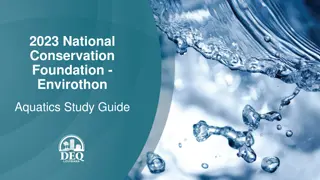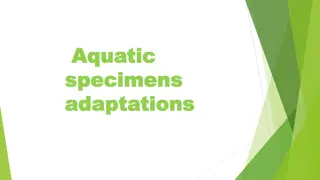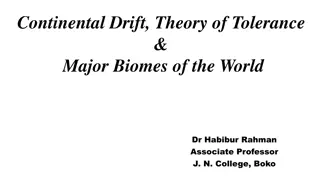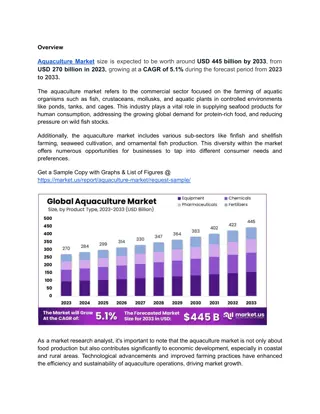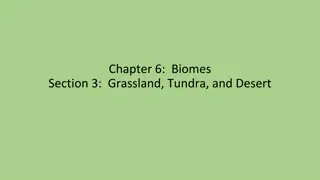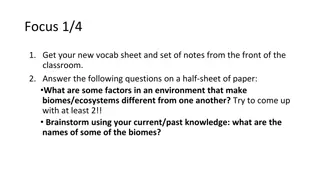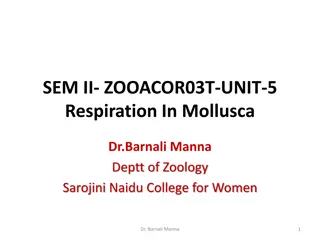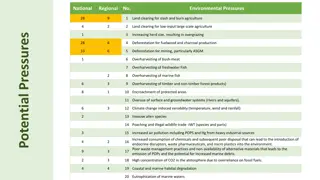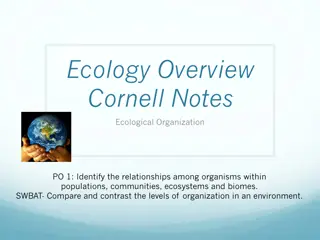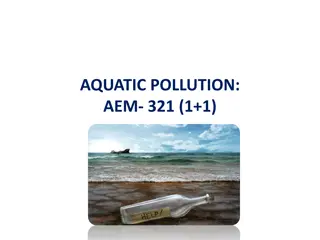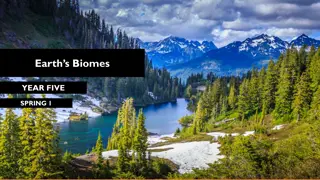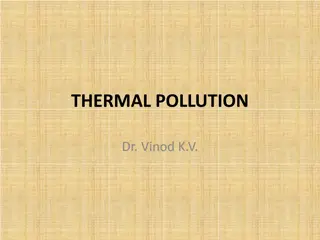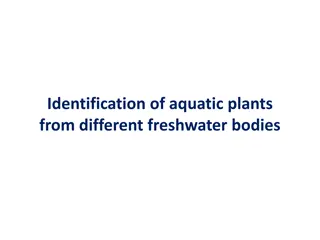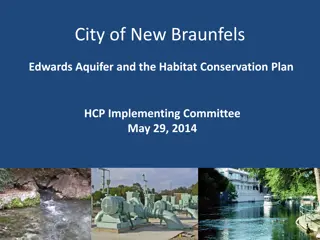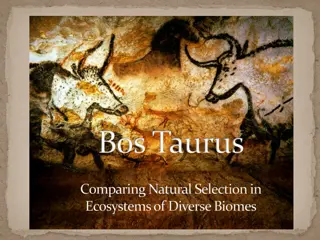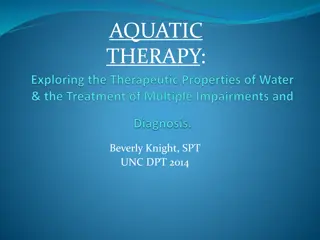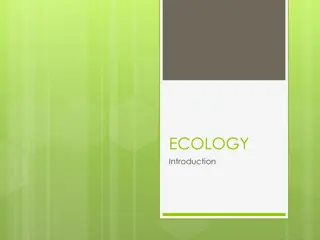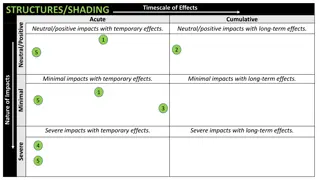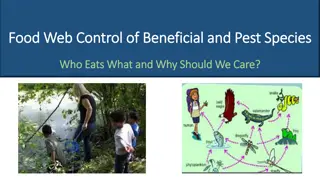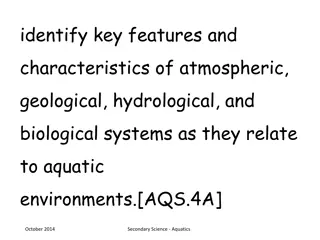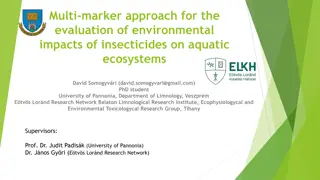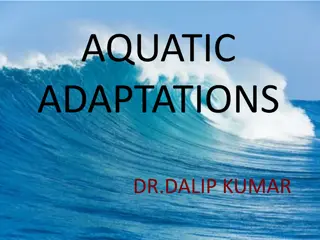Exploring The Best Swim School To Start Your Aquatic Journey
Are you trying to find the Best Swim School to start your aquatic career? Ace Dolphin is the only place to look. Ace Dolphin, which is well-known for its dedication to quality, provides amazing swimming programs for people of all ages and skill levels. Let\u2019s explore why Ace Dolphin is an ideal
1 views • 3 slides
Dissolved Oxygen Measurements and Factors Affecting Oxygen Levels
Understanding the importance of dissolved oxygen in water is crucial for the survival of aquatic plants and animals. Factors such as chemical reactions, temperature, pressure, and light penetration influence oxygen levels. The Winkler method is commonly used for dissolved oxygen measurements. This m
4 views • 11 slides
Understanding Total Solids and Total Suspended Solids in Water
Learn about total solids and total suspended solids in water, including their definitions, implications on water quality and aquatic life, and factors affecting their levels. Total solids refer to matter suspended or dissolved in water, while total suspended solids are small solid particles that can
7 views • 12 slides
Sustainable Biomes for Industrial Materials Production
Explore biomes that produce industrial materials such as mineral resources and timber in Australia. Learn about the types of biomes, the impact of features on material production, and the differences between native and plantation forests for industrial timber. Discover how indigenous and introduced
6 views • 12 slides
2023 National Conservation Foundation - Envirothon
Explore the intricate dynamics of aquatic ecosystems and wetlands conservation through this comprehensive study guide. Discover the importance of watersheds, the hydrologic cycle, aquatic food webs, energy flow at trophic levels, and common macroinvertebrates in Louisiana. Learn about different wetl
3 views • 27 slides
Understanding Ecosystems: Ecological Interactions and Dependencies
Ecology is the study of how organisms interact with their environment, influencing their distribution and abundance. This exploration covers terrestrial and aquatic biomes, energy flow, environmental impacts, adaptations, and global ecosystems, emphasizing the interconnectedness of all living organi
2 views • 58 slides
Adaptations of Aquatic Specimens, with a Focus on Sea Snakes
Aquatic specimens, particularly sea snakes of the subfamily Hydrophiinae, exhibit fascinating adaptations for their fully aquatic lifestyle. These marine snakes are uniquely adapted for life in the sea, with specialized features such as paddle-like tails, compressed bodies, and the ability to respir
0 views • 16 slides
Exploring the Tundra and Taiga Biomes
Discover the unique characteristics of the tundra and taiga biomes, from the frozen landscapes of the tundra with its array of adapted plant and animal species to the coniferous forests of the taiga teeming with diverse wildlife. Learn about the extreme climate conditions and fascinating ecosystems
0 views • 28 slides
Continental Drift, Theory of Tolerance & Major Biomes of the World Overview
This detailed presentation explores topics like Continental Drift, the Theory of Tolerance, and Major Biomes of the World. It covers the history of the Continental Drift theory, from Wegener to Du Toit's modifications, and delves into the various terrestrial biomes that exist, including tundra, bore
2 views • 26 slides
Sustainable Aquaculture Products Attract Environmentally Conscious Consumers
Aquaculture Market By Product Types(Equipment, Chemicals, Pharmaceuticals, Fertilizers), By Culture(Fresh Water, Brackish Water, Marine Water), By Species( Aquatic Plants, Aquatic Animals), By End-User(Seafood Industry, Pharmaceuticals, Others), By R
0 views • 4 slides
Grassland, Tundra, and Desert Biomes: Exploring Earth's Diverse Landscapes
Grassland, tundra, and desert biomes are unique ecosystems shaped by varying levels of rainfall. From the grassy plains of savannas to the harsh conditions of tundras, each biome hosts a diverse array of plants and animals adapted to survive in challenging environments. Discover the distinct charact
0 views • 28 slides
Understanding Biomes: Climate, Ecosystems, and Threats
Biomes are large regions with distinct climates, plant, and animal communities, each consisting of multiple ecosystems. The main factors shaping biomes are temperature and precipitation, influencing the types of organisms that can thrive in each region. Tropical rain forests, for example, are critic
0 views • 27 slides
Understanding Biomes: Climate, Vegetation, and Adaptations
Biomes are vast regions defined by climate, plant and animal communities. Factors like climate, geography, and vegetation impact the unique characteristics of each biome. Understanding biomes involves knowledge of climate, geography, vegetation adaptations, and animal diversity. Changes in one part
0 views • 23 slides
The Evolution of Aquarium Societies in Texas: A Historical Journey from 1932 to 2019
Explore the history of FOTAS - the Federation of Texas Aquarium Societies, from its inception in 1952 to its evolution into a yearly convention. Discover the chronology of aquatic organizations in Texas from the 1930s, including the formation of various aquarium clubs and their contributions to the
0 views • 33 slides
Respiration in Mollusca: Adaptations to Different Habitats
Mollusca exhibit various modes of respiration depending on their habitat - aquatic, terrestrial, or amphibious. Different respiratory organs are modified accordingly, such as ctenidia or gills for aquatic species, pulmonary sac for aerial species, and mantle or integument for those lacking specific
0 views • 17 slides
Environmental Pressures and Biomes Overview
The content provides an overview of various environmental pressures such as land clearing, deforestation, overharvesting, climate change, and more. It also outlines different biomes including temperate forests, tropical grasslands, deserts, and marine ecosystems. The document aims to highlight the c
1 views • 13 slides
Understanding Aquatic Adaptation in Animals
Aquatic adaptation refers to the changes in an animal's body organization to thrive in a water habitat. Vertebrates have evolved to lead partial or total aquatic lives, showcasing various adaptations. Water as a habitat offers a homogenous medium, stable conditions, and rich food resources. Aquatic
0 views • 9 slides
Understanding Ecological Organization in the Environment
Explore the relationships among organisms within populations, communities, ecosystems, and biomes. Delve into the levels of organization in different environments, from populations to the biosphere. Learn about primary and secondary succession, pioneer species, and how environments form. Discover th
1 views • 19 slides
Understanding Aquatic Pollution and Its Impact on Water Quality
Aquatic pollution is a significant concern affecting the environment and human health. It includes various pollutants entering water bodies from land-based activities, causing harm to aquatic life and humans. Pollution sources can be classified into point source and non-point source. Monitoring wate
2 views • 13 slides
Aquatic Treatment Systems for Wastewater Reclamation and Reuse
In aquatic systems, wastewater treatment involves bacterial metabolism and sedimentation, with aquatic plants playing a role in improving treatment capabilities. This article discusses the functions of aquatic plants in treatment systems and the categories of wetlands used for wastewater treatment,
1 views • 15 slides
Understanding Biomes: Concept, Classification, and Factors
Biomes are large natural ecosystems encompassing plant and animal communities shaped by shared physical climates. They are classified based on climate, vegetation, soil-water, and heat availability, encompassing diverse environments like deserts, forests, savannas, and oceans. The concept of biomes
0 views • 6 slides
Exploring Earth's Biomes in Year 5 Spring
Delve into the fascinating world of Earth's biomes through an engaging learning review in Year 5 Spring. Discover diverse ecosystems like tundra, desert, temperate broadleaf forest, tropical forest, grasslands (Savannah), and coniferous forest (Taiga). Enhance your knowledge of different climates, p
0 views • 11 slides
Explore Biomes: Test Your Knowledge with Biome Sorting
Delve into the fascinating world of biomes with an interactive activity to test your understanding. Identify different biomes, their characteristics, plant and animal adaptations, and where they are found. Review key concepts through engaging questions and images.
0 views • 8 slides
Understanding Biomes and Ecosystems in Nature
Exploring the concept of biomes and ecosystems, the interaction between living and nonliving elements in nature, the adaptation of species to their habitats, and the different types of biomes like tundra, forests, grasslands, deserts, and aquatic biomes. The extreme conditions of tundra and deserts
0 views • 18 slides
Understanding Carbon Storage in Biomes and Ecosystems
Explore the intricate carbon cycle within terrestrial ecosystems, focusing on carbon storage in biomass, litter, and soil. Delve into the differences in plant characteristics among various biomes and their impact on carbon sequestration. Gain insights into the distribution of tropical rainforests an
0 views • 13 slides
Understanding Thermal Pollution and Its Sources
Thermal pollution is the detrimental effect of heated effluents discharged by power plants on aquatic and terrestrial ecosystems. This pollution occurs when the temperature of water bodies rises significantly due to human activities, leading to a reduction in dissolved oxygen and impacting aquatic l
0 views • 19 slides
Identification of Aquatic Plants in Freshwater Bodies Based on Habitat Classification
Before identifying aquatic plants in freshwater bodies, it's vital to classify them into floating macrophytes, marginal macrophytes, submerged macrophytes, and emergent macrophytes. This classification aids in distinguishing various plant species such as Eichhornia, Salvinia, Pistia, Lemna, and Azol
0 views • 9 slides
Understanding Ecosystems: Climate, Biomes, and Management
Explore the relationship between climate and biomes on a global scale, focusing on hot semi-arid grasslands and one other biome. Learn about the physical processes linking living and non-living components in ecosystems, such as nutrient cycles and food webs. Discover how small-scale ecosystems in th
0 views • 4 slides
Exploring the Hydrological Cycle and Aquatic Environments
Dive into the fascinating world of the hydrosphere with a comprehensive look at the hydrological cycle, water properties, hydrology, salinity, aquatic biomes, and ocean facts. Discover how water moves through Earth's spheres, the distribution of freshwater, the significance of oceans, and their role
0 views • 31 slides
Discovering Earth's Biomes and Climate Through Jeopardy Questions
Explore Earth's diverse biomes and climate concepts by playing a virtual Jeopardy game. Test your knowledge on topics such as deserts, biomes, climate, atmospheric layers, and elemental compositions of air. Learn interesting facts about penguins, living organisms in the ground, winds, and more.
0 views • 27 slides
Conservation Plan for Aquatic Habitat Restoration in New Braunfels
This plan outlines various projects aimed at managing aquatic habitats in New Braunfels for the restoration and preservation of native species such as the fountain darter. It includes objectives like flow manipulation, non-native vegetation control, and restoration of aquatic vegetation in the Comal
0 views • 17 slides
Comparing Natural Selection in Diverse Biomes: Spanish Cattle Adaptations
Explore the natural selection of Spanish cattle in desert, swamp, and grassland ecosystems. Compare characteristics of Cracker and Chinampo cattle, highlighting their adaptations for survival in different biomes. Discover how these species thrive in challenging environments through unique physical a
0 views • 11 slides
Exploring Aquatic Therapy: Benefits, Techniques, and Research Findings
Aquatic therapy, presented by Beverly Knight, SPT, offers a unique approach to rehabilitation with properties of water like buoyancy and resistance. This therapy can benefit patients with various conditions such as chronic pain, arthritis, and neurological impairments. The content covers indications
0 views • 22 slides
Exploring Ecology: Interactions and Environments
Dive into the world of ecology, where organisms interact and rely on each other and their surroundings. Understand the concepts of populations, communities, ecosystems, biomes, and the biosphere. Explore the vocabulary of ecology, from individual organisms to entire biomes. Learn about food chains,
0 views • 14 slides
Marine Aquaculture Impacts on Submersed Aquatic Vegetation
The document explores the impacts of structures and shading used in commercial shellfish mariculture activities on submersed aquatic vegetation, particularly seagrasses. It discusses the varying effects of mariculture structures on eelgrass density, productivity, and the potential habitat they provi
0 views • 11 slides
Exploring African Biomes and Stereotypes in Year 8 Geography Homework
In this Year 8 Geography Homework booklet, students delve into the diverse biomes of Africa, challenge stereotypes, and work on climate studies. Tasks include defining stereotypes, mapping misconceptions, studying African biomes, and analyzing the climate of Algeria. The assignments aim to broaden s
0 views • 10 slides
Understanding Food Webs in Aquatic Habitats
Exploring the intricate relationships within aquatic food webs, this content delves into the control of beneficial and pest species, highlighting the importance of biodiversity and the factors that influence species presence and success. From the role of frogs in the ecosystem to the impact on tadpo
1 views • 6 slides
Understanding Aquatic Environments: Systems and Interactions
Explore the key features and characteristics of atmospheric, geological, hydrological, and biological systems in relation to aquatic environments. Apply systems thinking to analyze positive and negative feedback cycles. Utilize technology to collect and evaluate global environmental data. Evaluate d
0 views • 28 slides
Multi-Marker Approach for Evaluating Environmental Impacts of Neonicotinoids on Aquatic Ecosystems
Neonicotinoids, a class of insecticides, are widely used in agriculture but pose environmental risks to aquatic organisms. This study by David Somogyvári explores the effects of neonicotinoids on aquatic ecosystems using a multi-marker approach, focusing on the toxicity levels and potential impacts
0 views • 18 slides
Aquatic Adaptations in Marine Life
This informative content discusses the primary and secondary aquatic adaptations in marine animals such as fish, whales, turtles, and ducks. It covers various adaptations like streamlined bodies, presence of swim bladders, flippers for navigation, and webbed feet for swimming. Each adaptation is vit
1 views • 14 slides




